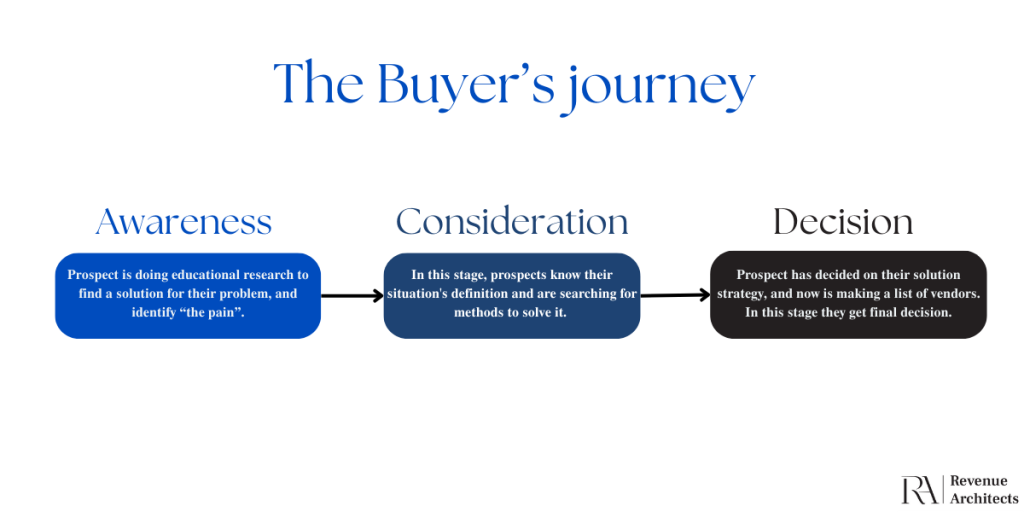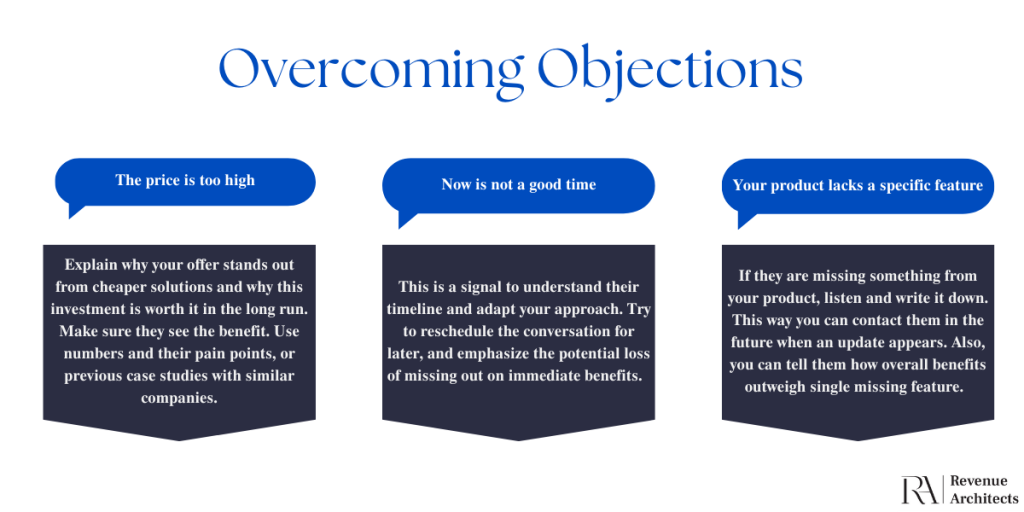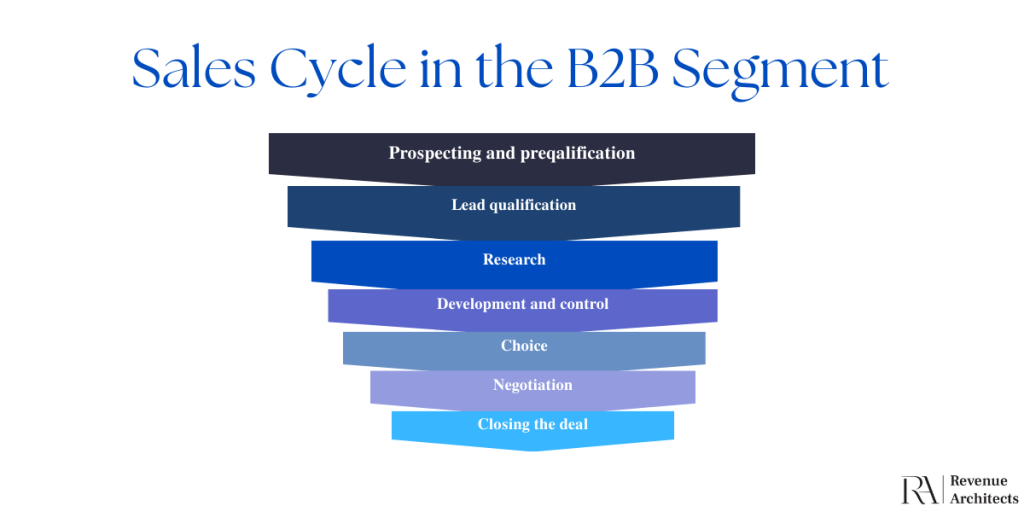The duration of working with a buyer varies depending on what’s being sold, whether goods or services. It could take a few minutes for food products or several weeks for B2B software sales. This process is known as the sales cycle.
A sales cycle is a defined stage of actions taken to make a sale. A potential buyer can be transformed into a regular customer by adhering to the correct sequence of the entire sales cycle. All stages of the cycle are applicable in any business field, but any niche has its own specifics.
If you understand how to complete the sales cycle faster, you will reach more customers, generate more revenue, and save time.
Now, let’s see the well-tested stages of a sales cycle that can help you reach better results.

Source: Image by Tung Lam from Pixabay
Stages of a Complete Sales Cycle
Stage 1: Sales Ideology
Many believe that the essence of the entire sales cycle is first identifying the buyer’s needs and then satisfying them. This belief is only partially accurate because a true sale occurs not when the buyer comes to the store with a pre-determined need but precisely when he has no intention of buying anything.
In such a situation, the sales ideology prompts the client to make a purchase. Understanding and addressing the buyer’s needs is crucial in this process, as it shows empathy and a customer-centric approach.
Often, the client wants to avoid buying something because he doubts the product’s quality, is unfamiliar with the manufacturer, or does not trust the seller. To succeed in trade, it is necessary to find an ideology in each product that will be reflected throughout the sales cycle and present it to the buyer.
This ideology is the unique selling proposition (USP) of the product, which sets it apart from competitors and appeals to the buyer’s needs and desires. For example, it offers not just vitamins but good health; not just coffee, but morning alertness; not just a vacuum cleaner, but cleanliness in the house, etc.
These aspects make up the sales ideology.
Stage 2: Finding Clients
The most crucial stage in the sales cycle is finding a client. Sure, there are many stores, like supermarkets, where people come to shop, and there’s no need to run around town looking for new consumers. But even in this case, you need to ensure buyers come to your store, not the one across the street.
Finding new clients is a fundamental element in most trade organizations with narrow specialization in the sales cycle. It allows them to sell their product or service. Here, more than just advertising is required. Manager activity is necessary for success.
To find buyers interested in a specific product, it is necessary to set prices and decide how to present the product correctly. There are several ways to succeed at this stage of the sales cycle, such as conducting market research to identify potential customers, using social media platforms to reach a wider audience, offering discounts or promotions to attract new customers, and partnering with other businesses to expand your customer base.
ABC Analysis based on the Pareto Principle is a strategy that focuses on the most profitable clients. The Pareto Principle states that 80% of your profits come from 20% of your clients. By identifying and prioritising these high-value clients, you can maximise your sales and improve your overall business performance.
How can you prioritise them?
Consider adding them to a specific mailing list, enrolling them in a loyalty program, sending them gifts and samples, and allowing them to test out new features before anyone else does.
Stage 3: Sales Strategy and Negotiations
An important rule of successful trade is to follow the sequence of each stage of the entire sales cycle.
To successfully negotiate, you need to decide the following:
- How do I start the conversation?
- How do we transition to the next stage of the conversation?
- Should you demand something from the buyer?
- When is the right time for a gift or compliment, and at which stage of the sales cycle?
- How do you manipulate the buyer?
- How do we move to the next stage of the sales cycle?
- What special offers does the company have, and what can you concede to the client?
- How do you lead the buyer to the most crucial sale stage – making the deal and ending the conversation?

To develop the right strategy for each stage of the sales cycle, one must possess specific knowledge and skills in negotiation and be able to present the product correctly. Only some managers are professionals capable of flawlessly navigating all sales cycle stages, including negotiations.
Therefore, many potential deals that would be successful with the right strategy have yet to conclude. Also, if you have developed a primary negotiation strategy, you cannot unthinkingly follow it and hope for the success of every deal. Depending on the situation, you must be flexible and change your plan quickly.
Stage 4: Cold Contact (Discovery calls)
A discovery call with a client is one of the most challenging sales cycle stages.
Many beginners in trade find it difficult to overcome the psychological barrier and start a conversation with someone who initially does not care about what you have to say. (Don’t worry, we have plenty about this topic in our revenue books and on our blog).
Creating contact with a buyer is a critical stage of the sales cycle that aims to:
- Draw the visitor’s attention to get the chance to talk about your products and services.
- If it’s a phone call or meeting in neutral territory, all actions should aim to interest the client in a meeting on the seller’s premises.
- Complete the entire sales cycle with a deal.
- Today, there are many ways to make yourself known and establish the first contact with a client remotely: sending emails and SMSs, phone calls, advertising on the internet (forums, bulletin boards, social networks), etc.
However, all these methods of delivering information work much worse than personal contact with the buyer.
During a live conversation, you can receive the client’s reactions, conclude them, and adjust the direction of the conversation based on the interlocutor’s behaviour. Your role in establishing this personal contact is significant, as it allows for a more nuanced understanding of the buyer’s needs and reactions.
Stage 5: Beginning Personal Contact
A very responsible stage of the sales cycle is establishing personal contact with the client. Favourable conversation conditions must be created for this stage of the sales cycle management to succeed. The atmosphere should be conducive to a conversation where the client feels relaxed and comfortable, and a list of questions should be prepared. There’s a secret – all questions should be designed so that the potential client answers positively. This psychological technique will push him on a subconscious level to say “Yes!” to the question “Would you like to buy this…?”
The entire cycle of establishing personal contact is divided into four stages:
- Impression: It’s known that the first impression of a person is formed in our subconscious in the first few minutes. It is formed based on what we see and hear. Therefore, appearance, facial expressions, dialogue skills, tone, tempo, speech volume, gestures, distance, and negotiation etiquette are essential at each sales cycle stage. The goal of this stage is to make a positive and lasting impression on the client, which can significantly influence their decision to buy your product or service.
- Establishing Good Relations: If you can win the client’s favour, you can manage his actions because he will start to trust you and listen to your advice.
- Individual Approach: Each client requires specific attention. A sales manager should strive to make the client feel significant while communicating with him. This requires finding a unique approach for each buyer. To do this, you can always use data from your CRM (location, age, gender, etc). Try to find a common topic that isn’t strictly related to business, like if they come from a city with a famous sports team.
- Creating a Positive Attitude: Communicate with the client in a positive tone at all stages of the sales cycle. Be friendly, keep a smile on your face, and maintain calm.
Stage 6: Preliminary Offer
A client’s attitude towards a company often depends on his impression of communicating with the manager. The client manager is the company’s face, and the company’s image and reputation depend on the work of one manager, so he needs to be able to carry out each stage of the sales cycle correctly.
How a client evaluates the company and what impression he forms about its service depends on how the manager presents the product and conducts the dialogue. A meeting with a client does not necessarily have to occur in the company’s office; it can happen in neutral territory or at the buyer’s location.
When you have found a client, you must move to the next sales cycle stage – making a preliminary offer. At this time, you can provide some details and general information about the product and the company’s activities so that the client understands what it is about and wants to know more.
Stage 7: Client Orientation
The entire sales cycle is built on using a competent strategy. Knowing your client makes developing a strategy correctly easier. You need to understand whom you are dealing with to determine the client’s type, interests, preferences, concerns, and opportunities in advance.
This will help you better understand how to influence the buyer and prompt him to make a deal.
Similarly, at this stage of sales cycle management, if your client is not a single individual but an entire organization, you must gather and study all necessary information about the firm—its area of activity, working principles, and needs.
Stage 8: Main Effective Offer
Several rules must be followed at this stage of the sales cycle to make a compelling offer:
- The offer must benefit the client. It’s best if he feels that it is explicitly intended for them.
- Please discuss the product’s advantages and the benefits the client will receive by purchasing it. If necessary, use discounts and bonuses.
- The client must feel significant to you: Earn his trust and respect.
- Presentation of the product: This stage of the sales cycle requires special attention because the success of the client’s decision to buy the product depends on how well the presentation is conducted.
It is better to prepare for this stage of the sales cycle in advance so that the product presentation is attractive to the client and not dull or prolonged. The first impression of the product you present should form in the client’s mind within 15 seconds of the conversation.
Stage 9: Overcoming Objections during Sales Cycle
If the manager has carefully worked through all previous sales cycle stages, he might avoid dealing with objections. However, this is rare because clients usually have their own opinions, which often differ from the seller’s. Consequently, every salesperson encounters the sales cycle stage, known as dealing with objections.
They can arise for various reasons: the client does not need the product, has not found any benefits from it, has something similar, has seen a cheaper option, is already working with competitors, etc. On average, a manager has to address four to six objections per deal.
To respond correctly to an objection, it is necessary to understand its nature and at what stage of the sales cycle it emerged. Common reasons for objections include:
- Financial Constraints: The client cannot afford the product and does not want to say so directly.
- Lack of Interest: The manager failed to interest the client because he could not present the product properly or behaved incorrectly at some stage of the sales cycle.
- Dissatisfaction: The client was not pleased with the interaction with the manager.
- Timing: The buyer is not ready to purchase the product immediately and is considering future options.
- Doubts: The client needs time to think over and make a decision.
Here are some examples of how to overcome objections, and if you are having trouble with a particular one, you can book a coaching session with Mario or Noam.

Stage 10: Negotiating Terms, Price, and Bargaining
Every client aims to buy a product at the lowest possible price. Often, the price plays a crucial role in decision-making. In some situations, a client initially intended to wait to buy the product but noticed it on sale at a reduced price and left the store with a purchase that day. However, a company can only sometimes afford to lower prices as much as the client expects.
Therefore, during the stage of the sales cycle involving price negotiations, you need to learn to:
- Justify the cost of goods and services.
- Communicate the price positively: “For an additional 2 dollars, we will add more sauce to your sandwich.” Focus on the benefit, not the price.
- Before discussing the price, you must engage the client in purchasing during the previous sales cycle stages.
- If the client is not initially interested in the product, the price might deter him even more (unless it is discounted).
- If the client likes and wants to buy the product, he will likely do so even if the price is unsatisfactory.
Sometimes, it is enough to determine the client type to work with him correctly. There are two main types:
The first type is clients who never haggle and buy the product at the listed price. If the price does not suit them, they will leave without buying.
The second type is people who always look for compromises and bargains, buying the product only after a discount.
Stage 11: Closing the Deal
You must constantly monitor the client’s behaviour to handle the closing stage of the sales cycle correctly and save time on negotiations that are no longer necessary because the client has made his choice.
This will help you understand if he is ready to make a purchase. Signs that the client is prepared to buy include:
- Detailed Examination: The client begins to study the product closely, paying attention to minor details.
- Complaints About Competitors: The client complains about another company or its employee (your task is to listen with understanding but not discuss the situation or attack competitors).
To behave correctly during the closing stage of the sales cycle, it is essential to:
- Pause after the presentation: Give the client a chance to express his opinion. Only then move to other stages of the sales cycle.
- Maintain an individual approach: Tailor your strategy to each deal.
- Constantly inquire about the client’s opinion: Ask clarifying questions.
Stage 12: Post-Sale Service and Support
It is believed that retaining a regular customer is much easier than attracting a new one. This is because attracting a new client requires going through many stages of the sales cycle that have already been completed with an existing client, such as presenting the product or the company.
You also won’t need to spend on advertising or pay a manager to find the client.
Retaining a client is quite simple—you need to regularly and unobtrusively remind him about yourself and keep his interest by informing him about new arrivals, promotions, and sales on time.
SMS campaigns, emails, and phone calls are proven to maintain client contact. Regularly performing this crucial sales cycle stage will ensure the client feels the company’s attention.
Stage 13: Debt Recovery
Today, the credit and instalment payment system is widespread in trade. This applies not only to cars, expensive furniture, or fur coats but also to ordinary boots, which are already relatively inexpensive. Although credits attract clients by making your product more accessible to them, they complicate the existence of many companies.
Many sellers do not use the credit system because they need to learn how to manage the debt recovery stage of the sales cycle.
These difficulties are due to:
- Lack of data: No data on increased costs related to the term and amount of the debt.
- Lack of effectiveness assessment: No assessment of the credit system’s effectiveness.
- No clear repayment information: No accurate information on debtor firms’ repayment terms.
- No strategy for overdue debt management: No strategy for dealing with overdue debts.
- Lack of buyer creditworthiness assessment: No evaluation of buyers’ creditworthiness.
Thus, managing accounts receivable at the debt recovery stage of the sales cycle is a very important and complex part of the company’s operations, requiring developing a special system based on a comprehensive approach.
Stage 14: Handling Categorical Refusals
Even if you flawlessly complete all sales cycle stages, you will still periodically encounter clients who refuse to buy your product or service. However, do not perceive this as a failure because you missed the sale but not the client. If he did not want to buy a vacuum cleaner today, he might come back in a month for a TV, for example.
To increase the chance of a future purchase, you need to demonstrate professionalism, excellent product knowledge, and a willingness to be happy to see him. This will allow you to continue working with the client without returning to the initial stages of the sales cycle.
To do this, you need to:
- Repeat the offer: Offer the product or service again.
- Approve the client’s decision: Even if he refused to buy.
- Understand the reasons for refusal: Find out why he made that choice to understand where the sales cycle fell short.
Stage 15: Sales Promotion
Sales promotion involves a set of measures to promote the product from the manufacturer to the end consumer. It can be conducted in the following ways:
- Advertising at sales points.
- It attracts potential buyers through contests and lotteries.
- Seasonal promotions and sales.
- Gifts and bonuses for purchases.
- Money-back guarantees if the product does not fit.
- Information dissemination in magazines.
- SMS and email campaigns about discounts and benefits.
- Demonstrating the product’s operational capabilities.
- Providing free samples and trial products.
- Marketing specialists constantly develop new sales promotion methods, so it’s necessary to keep track of all innovations and improve your sales skills.
Critical Stages of the Sales Cycle in the B2B Segment

1. Prequalification
Despite its simplicity in terms of business, this stage is significant enough to be separately identified in the sales cycle. Here, we learn that a client fits the “profile of our client,” and he has shown interest in our products or services.
This information usually comes from incoming correspondence (electronic or paper), phone calls, website inquiries, and cold calls. No action is taken if the data check reveals that the client does not fit the established parameters. If the preliminary check shows the client fits the profile, the data is forwarded to the sales department, where it moves to the next stage—qualification.
2. Qualification
At this stage, the employee decides whether the information is reliable and whether further work with the prospect is worthwhile. His responsibilities include checking if the lead fits the “client profile” and identifying the problem he aims to solve with the company’s services or products.
The difficulty is that client involvement at this stage is minimal.
Suppose it is decided that the potential client fits the criteria. In that case, he is entered into the “pipeline,” where a strategy for the sales department’s actions and tasks to be performed at subsequent stages is developed. Work stops if the client does not fit any parameter, making success unlikely, though sometimes the decision to continue interaction is made.
3. Research
As the name suggests, this stage is for both the seller and the buyer. The buyer actively studies the market to choose companies that provide the necessary products or services. He then compares these companies to select the most advantageous ones.
The seller studies the client’s requirements regarding delivery terms, volumes, etc., and accordingly develops a strategy for dealing with this client. The seller forms a team that will handle each stage of the sales cycle. Depending on the deal’s significance, it could involve one client manager or a group of employees of different levels.
4. Development and Control
This is the primary and most crucial sales cycle stage for both the buyer and seller. After selecting specific companies (usually one or two), the client starts the decision-making process and checks his financial capabilities. The client contacts representatives of the interested organisation and requests a price offer and terms of the deal.
The seller must create the most advantageous and exciting offer for the client based on the data obtained in the previous stages (“Research” and “Qualification”). The buyer and seller organize meetings to discuss product or service presentations and deal terms.
5. Choice
At this stage, the client analyses the advantages and weaknesses of several top suppliers to develop a strategy for further interaction with the best candidate. This is when critical employees authorised to make final decisions get involved. A significant advantage for the company is genuine reviews.
Therefore, it is beneficial to provide the buyer with the opportunity to communicate with the company’s clients. The buyer will likely choose the supplier with positive feedback under equal conditions. At this stage, the seller prepares the documents needed to finalise the deal and sends them to the buyer for review.
6. Negotiations
Here, the final decision on choosing a supplier is made based on the results of previous stages, discussing price and all aspects of the deal. Discussed aspects can play a significant role, so everything should be considered. All deal details, such as delivery terms and final cost, are finalized, and the timing for signing the necessary documents is agreed upon.
7. Closing
If all previous stages were successful, the next stage—closing the deal—will inevitably follow. This involves the final agreement of all deal details and signing the required documents. This marks the beginning of further interaction between the company and the client, whether an individual or an organisation. Once you close the deal, your client will go to customer service, where you can help them upsell your product.
In Conclusion
Understanding and mastering the sales cycle is crucial for transforming potential buyers into loyal customers.
As sales professionals, it’s important to customize your approach to each stage – from understanding clients’ needs to presenting offers and overcoming objections. Flexibility in negotiation and strategy development is key. Retaining customers through post-sale support and using loyalty programs and effective debt recovery systems can enhance long-term relationships and financial stability.
If you need a tailored approach for your company’s unique needs, our experienced sales coaches are ready to help optimize your sales cycle. Get in touch today to start transforming your sales strategy!

